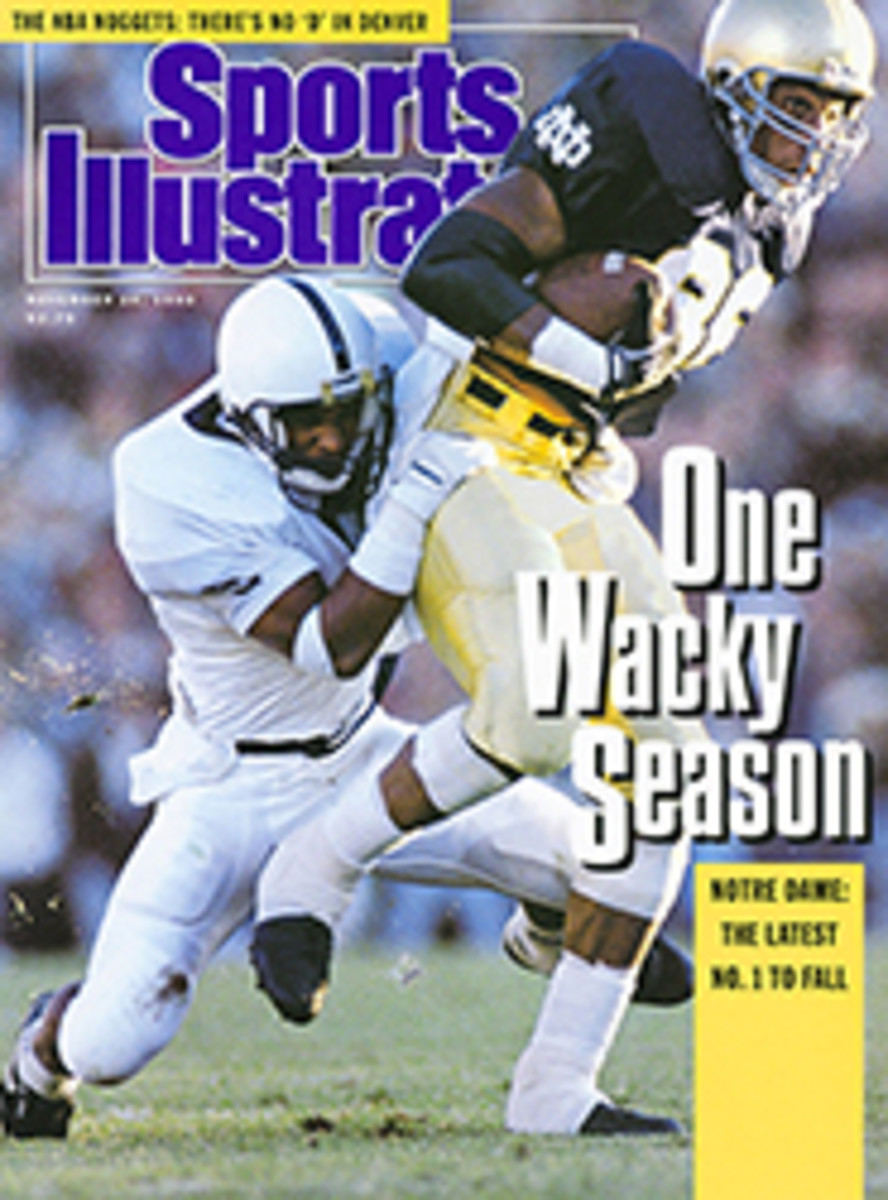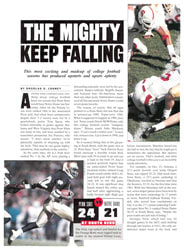
CREATOR OF A GLASS MENAGERIE
James Houston hovers expectantly in front of the red, glowing furnace, known at the Steuben glassworks in Corning, N.Y., as a glory hole. He ignores the intense heat as he focuses on the master glassblower before him, who spins molten glass on the end of a pipe.
Slowly, a birdlike shape begins to form, and Houston, the emerging fowl's designer, alternately gasps and cajoles, giving instructions, observations and the odd word of encouragement. At central casting, Houston, with his jutting chin and erect carriage, would land the role of the Royal Scots commanding officer. Though reserved, he is far from stiff. At 69, he moves around the glass factory like a kid in a huge sandbox.
Leaning in close, as if smelling a roasting bird, Houston cannot contain his excitement. "Can you see it, Harry? See it now?"
Harry Phillips, the gaffer, or blower, raises an eyebrow in response, one hand spinning the glass, the other working a shaping paddle. "It's a dodo, right, Jim?"
The small gallery gathered around to observe the debut of the 82nd Steuben work by Houston chuckles, relieved that the tension has been broken. Houston shyly acknowledges the ribbing. He steps back as Phillips swings his pipe into the glory hole to reheat the sculpture. "There is a lot of pressure in creating a piece like this for the first time," says Houston, holding up a sketch of the spread-winged pheasant he hopes will eventually take flight off the blower's pipe. "It is like capturing any image you find in nature—a salmon jumping as it swims upstream, or a deer you see standing still in the middle of the forest. With glass, you only have a few seconds to capture that image, or it's lost."
Houston's work has long occupied a unique niche among the famous crystal art objects produced by the Corning factory. Since joining the Steuben team of designers in 1962, he has translated to glass such scenes from the outdoors as a trout rising to a fly, geese flying south in formation, dolphins diving into the sea, polar bears, bonefish, penguins, ice hunters, dancing cranes. His creations are not simply observations sketched on walks in the woods. Houston sculptures are equally about image and material: Bubbles rising in the glass of a bowl provide the turbulent water in which etched salmon swim; clear glass is the ice through which Eskimos hunt their dinner.
His sculptures are prized by collectors around the world who are apparently un-fazed by a price tag of $1,900 for a trout rising to an 18-karat-gold fly, or $5,000 for two dolphins with sterling silver tails leaping into solid crystal. Houston's popularity also extends to Steuben's not easily impressed craftspeople. For them, many of whom grew up hunting and fishing around the Finger Lakes region of New York State, Houston's designs and love of the outdoors make him a kindred spirit.
Yet as comfortable as he feels amid the furnaces in Corning, Houston is most at home in a pair of waders, casting for trout in streams near his 18th-century town house in Stonington, Conn., or for salmon in the Tlell, which runs past the study of his house in the Queen Charlotte islands off the coast of British Columbia. Wherever he is, Houston rises at 5 a.m. and takes a cup of tea to his studio, where he draws or writes (he is the author of 23 books, including the best-selling The White Dawn: An Eskimo Saga, a 1971 novel that he also adapted for the screen in 1973) until early afternoon, when it is time to take up the fly rod. It is an enduring passion he shares with his wife, Alice, to whom he pays the compliment "She not only casts a great fly, she makes the best salmon mousse I've ever had." Houston says his most creative moment is "just before five, when I'm half-dreaming the scenes I've observed in nature."
These twin passions for art and the outdoors were sparked early in Houston's Toronto childhood by his father, James, a traveling salesman who brought back North American Indian artifacts from his trips, and by his mother, Gladys, who encouraged his drawing talent. The sale of a drawing at age eight convinced young James that "this was going to be a great way to make a living." After serving in World War II and studying art in Paris, Houston found himself yearning for Canada's northern territories, and in 1947 he set out with sketchbooks, a can of peaches and a one-way ticket to the Arctic.
"I felt totally at home the minute I was there," he claims, though he admits that learning the Inuktitut language, mastering Arctic survival skills and eating raw seal meat did not come easily. He found that the Eskimos and he shared the same passion for art. "They had no inhibitions about taking the drawing pad out of my hands and trying it themselves. To them, art is something everyone does." Houston encouraged his new friends to sell their unique stone carvings in the cities. Within eight years, Houston's marketing skills enabled the local artists to create the West Baffin Eskimo Co-op, an enterprise that was making nearly $100,000 a year by the early '60s.
In the meantime, Houston's own reputation as an artist was growing. After a visit by Steuben's president, Arthur Houghton Jr., in the summer of 1959, Houston for the first time gave some thought to glass as an artistic medium. "Houghton was very impressed with our local artists," recalls Houston, "so I tried to convince him to fund a glass studio up there and train the Eskimos. Instead, he said, 'I've got a better idea. Why don't you come to Corning and design for Steuben?' It took a couple of years, but I finally made the move."
Houston was enthralled on his first visit to the glass factory. "At that time they were running three shifts around the clock," he says, leading the way downstairs in the factory to where the glass is mixed. "Arthur Houghton suggested I work the night shift. Men would bring in venison and we would roast it in the glory holes. I kept thinking, The Eskimos would love this."
The basement below the furnaces is a jumble of pipes and cauldrons, just the place where one would expect Steuben to jealously guard its secret formula of sand, ash, lead and glass cullet—ingredients that are combined and heated at approximately 2,500° F. Here the glass is mixed as delicately as a soufflè. Most glass in which the tiniest bubble or imperfection is seen is thrown back into the cullet heap to be remixed. Other glass, such as that in Houston's salmon bowl, requires the deliberate creation of imperfections to simulate bubbles in the water, by a process that is a company secret.
On this day in April, Houston moves to a small platform where a worker receives orders for glass from the gatherers, whose job it is to pick up the glass for their gaffers. While he stands there, Phillips's order for Houston's second pheasant attempt of the day comes down: three minutes, 45 seconds. Gaffers do not measure glass in terms of volume or size, but in how long it takes for the viscous material to flow. At the precise second, the measurer cuts off the flow of glass, snips the excess with a pair of heavy scissors and then sends the glass up a tube to the main floor, where it will be picked up by the waiting gatherer.
Upstairs, the gatherer completes a rough shaping of the material and hands it to the gaffer's first assistant, the servitor. Phillips's servitor reheats the glass in the glory hole and forms the general working shape. At this point, it doesn't even resemble a dodo. Yet when Phillips (a 45-year Steuben veteran who is nearing retirement) takes the handoff, he will know, according to Houston, "whether he has even a few seconds too little or too much glass."
Houston catches sight of Phillips starting on the next pheasant and hurries over to watch the second attempt. By the time the servitor hands off the glass to Phillips, it has been shaped into a molten ball with the help of a rounded wooden block. Phillips's tools—wooden bowls, paddles and metal calipers—are identical to those used by glassblowers as far back as the 17th century. Constantly reheating and spinning the glass in the oven, he uses the paddle to give a rough shape to the body. He then uses a pair of rough tongs to pull out the neck and head of the bird, again smoothing it out with a paddle as lightly as one would pet a rabbit. As a pipe is stuck into the bird's tail feathers, Phillips and his servitor complete the delicate task of transferring the pheasant onto another pipe connected to its underside so Phillips can finish off the tail, wings and comb.
Houston is most concerned with the detailing of the comb, the determinant of the pheasant's masculinity. "It's a lot easier to make the female," he says. "No head feathers." When both men are satisfied they can fiddle no more, a servitor with heavy asbestos mitts takes hold of the bird. Phillips gives the pipe a sharp rap and the glass connection comes free. The underside will eventually be polished until the glass is clear and clean.
Amid critical clucks and furrowed eyebrows, the servitor takes the pheasant to the lehr, or moving, ovens. The glass is placed on a slow-moving conveyor belt. The entry end of the oven is extremely hot, while the exit end, 56 feet eight inches away, is at room temperature. The two days required for the pheasant to travel from one end to the other will ensure that the glass develops no cracks or internal fissures.
No one can say why, but this pheasant doesn't quite measure up to the first attempt. Perhaps the body is not full enough or the comb prominent enough, but most present agree it will end up in the cullet bin, the graveyard for imperfect crystal creatures. Though there is some disappointment at the wasted hour (two or three times as long as it takes for most Steuben production pieces), Houston's and his peers' eyes are alight in anticipation of the third attempt. They will make several more before the design is submitted for approval. When it is "passed," Steuben will set the sale price and decide how many the edition will comprise.
"Every time we try a new piece, I end up seeing or realizing something I hadn't known before," says the pheasant's creator. "A drawing like this is flat-footed compared to glass. Glass has its own life. Sometimes its qualities can show you things you've never seen or imagined, and at other times it'll completely ruin you. I'm lucky. The Eskimos really prepared me for this. They taught me never to worry and to have a lot of patience."
PHOTO
BILL BALLENBERG
Houston (left) is intent on Phillips's work in the glory hole.
TWO PHOTOS
BILL BALLENBERG
Houston initially sketches his design (above), often refining the details on a clay model.
A former staff writer for "M," Kent Black is now a free-lance writer based in New York City.

